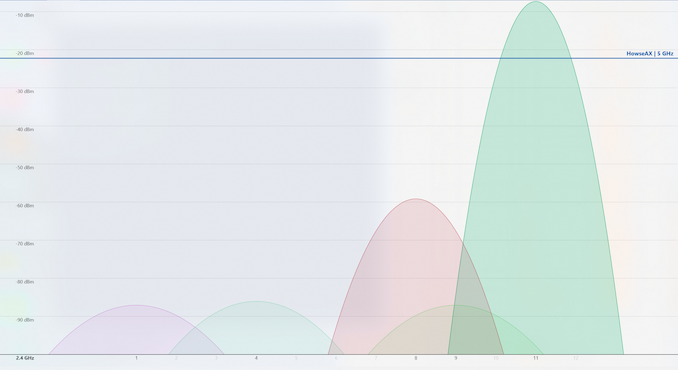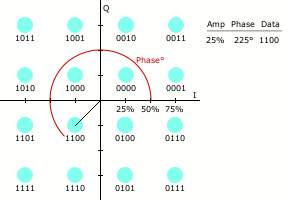AT 101: Wi-Fi 6 And Why You Want It
by Brett Howse on February 12, 2020 8:00 AM ESTWi-Fi 6: What’s New
With each successive new Wi-Fi standard, there are almost always improvements to the wireless speed and latency, and that continues with Wi-Fi 6, but the latest standard also improves power efficiency, and likely most importantly, helps address some of the typical issues with Wi-Fi in very crowded environments.
Let’s start with the last point, since it is arguably the most important. As Wi-Fi has become ubiquitous, and as the number of connected devices has grown, one of the biggest issues it has become susceptible to is overcrowding of the spectrum, which can cause even the best networking equipment to slow to a crawl. This is especially obvious in dense urban environments, or stadiums, or theme parks and the like.
What’s your frequency, router?
Only a few years ago, even mid to high tier laptops would ship with just 2.4 GHz 802.11n (Wi-Fi 4) network adapters. If they were to be used in a dense apartment complex, the resulting performance would be abysmal. Moving to the 5 GHz range provided some temporary relief, partly because of the reduced range of the 5 GHz signal, meaning neighboring access points would be less likely to interfere, but also due to 5 GHz offering significantly more channels. 2.4 GHz can only provide a maximum of three non-overlapping channels, but depending on the regulations of each country, there are a total of fourteen total channels, each being 22 MHz wide, but offset by only 5 MHz, so channels side by side will interfere with each other. On the 5 GHz side, there can be up to 23 channels, and none of them overlap.
5 GHz Channel Use in my home
If you needed range, 2.4 GHz was still your best bet due to the attenuation of the 5 GHz signals through solid objects like floors and walls, but in a dense environment, 5 GHz was practically a must-have for any wireless communication.
2.4 GHz Channel Use in my home
But even the 5 GHz space is now getting stretched to its limit, so the Wi-Fi Alliance has added some features to address the crowded spectrum directly. One of the major additions to combat this is Orthogonal Frequency-Division Multiple Access, or OFDMA, which breaks the spectrum into time-frequency resource units, which are coordinated by the access point. These resource units can be allocated to multiple connected devices, allowing them to transmit over the same channel at the same time, as long as the total bandwidth does not exceed the channel width. Previously, every transmitting device would occupy the entire channel for the entire time it was transmitting, so if multiple devices were competing, they would have to wait their turn using Time-Division Multiple Access, where each device would be given a slice of time to transmit. OFDMA spreads out channels to many clients, which can be very beneficial, especially if no single device requires all of the available bandwidth. In addition, Wi-Fi 6 allows for dynamic fragmentation of the packet size, allowing the device to fill available resource units with smaller packets, unlike previous Wi-Fi which required a fixed packet size.
Another interesting trick the Wi-Fi Alliance has added to combat crowding of the spectrum is Spatial Frequency Reuse, which allows devices to figure out if signals that are being transmitted are part of their network, or part of a neighboring network. This means that, for example, two people in an apartment complex were both using Wi-Fi 6 access points and devices, the devices connected to their own access point would be able to read a marker on the channel transmission and determine if that transmission is on their network or not. If it is not, and if the power levels are sufficiently low, the wireless device would be able to also transmit on the same channel at the same time. The devices would adapt their power levels for transmission to avoid them actively interfering with each others’ transmissions.
In addition to this, Wi-Fi 6 also adds an additional network allocation vector (NAV) which should help prevent packets being reset by overlapping networks.
Even with these changes, the Wi-Fi Alliance knows that there is still only a fixed amount of bandwidth even in the 5 GHz range, and as such 6 GHz support is already in the specification, although it will be limited to devices labeled as Wi-Fi 6E, to keep things at least a bit confusing.
A Bonding Moment – Doubling Down on Performance
Although the nominal channel bandwidth for Wi-Fi is 20 MHz, the Wi-Fi specifications have allowed for bonding of multiple channels together to provide higher performance channels. Wi-Fi 4 allowed for 40 MHz channels, and Wi-Fi 5 allowed for 80 MHz and 160 MHz, although the latter was optional, and we didn’t really see it in the PC space until recently. Because it was not a requirement, many Wi-Fi 5 access points and routers did not support it, even if you had one of the most recent wireless adapters which even offers 160 MHz support. Wi-Fi 6 supports the 160 MHz channel width, so we should see more devices adding support. But a drawback of bonding is that it requires concurrent channels to function, and with a limited number of channels, if you had a lot of interference on one channel, it could cause issues. This has somewhat been addressed in Wi-Fi 6 with “80+80” bandwidth, which means that the 160 MHz bonded channel can be made up of two different sets of 80 MHz channels. This was again available in the previous spec, but optional.
To further increase performance even further than just wider channels, Wi-Fi 6 also adds support for an even higher level of Quadrature Amplitude Modulation (QAM), from 256-QAM in Wi-Fi 5, to 1024-QAM in Wi-Fi 6. This moves from 8 bits per tone to 10 bits per tone, allowing more data to be transmitted over the same channel bandwidth. This means that a single 1x1 20 MHz channel can transmit at a maximum of 143 Mbps, and on a typical laptop with a 2x2 Wi-Fi adapter on 160 MHz channels can connect at 2.4 Gbps. The same 2x2 solution on a typical Wi-Fi 5 access point with the typical 80 MHz channel width offers just 867 Mbps, so the jump in performance for Wi-Fi 6 is significant.
16-Level QAM - By Chris Watts - Own work, CC BY-SA 3.0, Link
In addition, Wi-Fi 6 adds in support for Multi-user Multiple-input and Multiple-output (MU-MIMO) to the uplink connection as well, where Wi-Fi 5 only offered it on the downlink side.
Do I need it?
The eternal question with networking is when is a good time to upgrade, and do the latest and greatest additions to the specification provide tangible benefits right now. This is always complicated on Wi-Fi by a lag between access points or routers and devices, and what the upgrade cadence is. Wi-Fi 6 is new enough that many people may not own devices that even support Wi-Fi 6, so upgrading to a new router or access point without devices supporting the new Wi-Fi 6 standard will mean that your devices are still leveraging Wi-Fi 5 or below, meaning there isn’t really a good reason to jump. If you are in the market for a new router or access point anyway though, clearly it is in your best interest to get the latest specification of the standard.
Where Wi-Fi 6 is going to add real-world benefit though is in a couple of scenarios. If your wireless spectrum is very crowded due to being in a dense urban environment, Wi-Fi 6 makes some significant upgrades to its networking stack to help address just that type of use-case. In addition, if you’ve got dozens of devices fighting over Wi-Fi, it may make sense, although the best benefits are achieved when both the access point and client are utilizing Wi-Fi 6.
Performance is also dramatically increased over Wi-Fi 5, so clearly in performance-bound scenarios, the upgrade may be worth the investment, although the tricky part about Wi-Fi 6 is that for the most common 2x2 scenario, where there are two transmit and two receive channels, Wi-Fi performance finally surpasses that of the typical Gigabit Ethernet that most people have in their homes, so although the performance will still be higher than Wi-Fi 5, Gigabit may be a bottleneck, and if so, additional networking equipment may be necessitated. There has been some movement on the multi-Gigabit Ethernet for the consumer, but less than we’d have expected at this point, so Wi-Fi to Wi-Fi may be the least-expensive option for best performance.













149 Comments
View All Comments
ksec - Wednesday, February 12, 2020 - link
Not only that. ( OFDMA It has compatibility problems and remains to be seen whether it works given the limitation ) It will likely end up like MU-MIMO where the benefits drops once you have non-MU-MIMO devices in the same location. ( i.e useless )160Mhz and 80+80Mhz are still optional. Meaning you wont get those sort of speed in vast majority of cases, no current 802.11ax Smartphone support 160Mhz or 80+80Mhz Channel. ( Both Samsung and iPhone ) Although Intel ( if I remember correctly ) do support 160Mhz, but then they decided to stop making 3x3 config for Laptop.....
WiFi 6E had the best chances to remedy all of this. But nope, all those features are still optional.
There were a few other features missing from the spec, oh I forgot to mention the spec is still in Draft as it has been delayed yet again.
The whole thing is a bloody pile of mess.
PaulHoule - Wednesday, February 12, 2020 - link
My experience with WiFi performance in the real world is that nothing beats having multiple access points and spreading the clients between them. Performance is just so much better when clients aren't fighting each other for access to the net, and this counts particularly for internet connections to the outside, where the most important WiFi parameter is packet loss.I am waiting for UNBT to come out with a WiFi 6 access point which is reasonably priced, and for that matter, to get any cliets that support WiFi 6.
digitalgriffin - Wednesday, February 12, 2020 - link
True Paul. I segment my network. I have a subnet for smart devices with it's own AP running on a unique frequency. I have another subnet for my streaming devices with it's own AP. It not only allows me to save bandwidth for more critical devices, but also allows me to monitor on a more granular level for data usage and potential hacking hijinx.The only disadvantage to this method is my android devices can no longer directly access devices like Roku.
imaheadcase - Wednesday, February 12, 2020 - link
This article is so silly.First the title says "why you want it". Then later it says "maybe". Then it shows "benchmark" for unrealistic speeds, with limited devices to test.
Then it totally glosses of the fact that its not worth it AT ALL if other devices are not the same spec.
Considering %99 of devices that come out are 2.4Ghz still, including top of the line cameras zero reason to upgrade to this.
I'm thinking the article was just put up for the ad revenue for the clicks.
Oh lets not even go over how they talk about the progression of the wireless standard that takes forever to ratify, it its speeds are still really weak when it comes to LAN.
Unless you live in an area impossible to wire with LAN, no reason to go wireless. I'm my experience in a PoE camera is even better than wireless camera setup!
PeachNCream - Wednesday, February 12, 2020 - link
Yes, the article title is was poorly thought out to say the least. I'd prefer if the facts were presented as facts and the decision about whether or not I wanted something would reside in opinions I form after the fact. Telling me I want something is somewhat narrow thinking.GreenReaper - Friday, February 14, 2020 - link
This is a problem with the whole "thought leader" aspect of journalism. At least they could leave open the possibility that you might *not* want it. Right now, on the face of it, that's not an option.Dug - Wednesday, February 12, 2020 - link
What does some walls mean? Can you please tell us how many walls, what kind of wall, height of ceiling, and the distance? In my mind you are saying that you are 3 rooms away? How big are the rooms? Or is it a hallway wall without doors?If you are going to have a "test bed" it would be nice to know the layout so we can judge if it matches our environment.
Thanks.
DanNeely - Wednesday, February 12, 2020 - link
agreed. Arstechnica posts floorplan diagrams for their wifi testing articles; which comes in particularly useful for testing mesh network kits with variable numbers of boxes.ascott.neu.edu - Wednesday, February 12, 2020 - link
how does dynamic fragmentation work? i.e, are packets reassembled before being sent to the internet, or are the fragments reassembled at the destination? most systems try to avoid fragmentation, as it requires reassembling packets, and actively try to identify the largest packet that can be sent without fragmentation. dsl usually required smaller packets to avoid fragmentation, as i recall. Gigabit "ethernet" is switched. no interference from others using the same network. store and forward, almost always delivers packets. wifi is more old school csma/ca, which isn't even as good as old fashioned csma/cd ethernet. collisions detected in hardware rather than waiting for ack/nak. No matter how fast your wifi is, there are still shared resources that may very well limit your throughput and latency to resources on the internet.damianrobertjones - Wednesday, February 12, 2020 - link
"Wi-Fi 6 And Why You Want It"I don't actually want this.